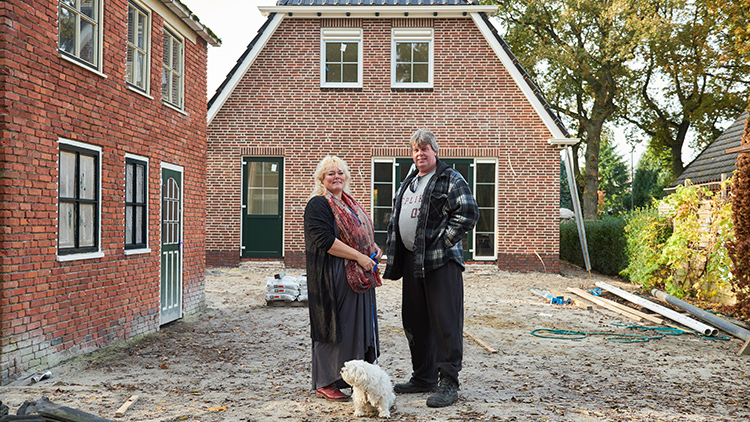Measuring the impact of earthquakes in Groningen
The NAM joint venture operates the Groningen gas field in the Netherlands. Since a significant earthquake in 2012, the NAM has studied the impact of earthquakes associated with the gas production on the residents. The studies have helped the NAM to implement and improve measures that address the impact on the residents.

Frits and Ada Indri, who live near the Groningen gas field in the Netherlands, had their house rebuilt to be earthquake-proof after it was severely damaged due to an earthquake.
Since 1963, the NAM joint venture (Shell interest 50%, ExxonMobil interest 50%) in partnership with the Dutch government, has operated the Groningen gas field in the Netherlands, one of the largest onshore gas fields in the world.
Regrettably, gas production caused a large number of earthquakes in the area, which have damaged homes and buildings, and caused anxiety for people locally. Various measures are in place for this impact, such as improvements to damage claim handling and a value loss compensation scheme. As a result of the earthquakes, the Netherlands Ministry of Economic Affairs has significantly limited gas production in Groningen since 2014. The measures included production limits in areas where the earthquakes caused the greatest damage and highest social impacts. Earthquakes in Groningen are becoming less frequent. In September 2016, the ministry approved the production of 24 billion cubic metres of gas per year in Groningen until October 1, 2021, and will review these production levels each year.
Improving quality of life
Shell supports NAM and the government as they take the necessary steps to improve the situation. This includes ensuring production levels are safe; repairing damage and where necessary strengthening houses; and supporting regional programmes to improve quality of life and economic development. As part of this, NAM is also working closely with local residents and other relevant parties including the National Coordinator for Groningen (NGC), Centrum Veilig Wonen, the Ministry of Economic Affairs and experts on these subjects. The various roles continue to evolve. As an example of this is that on 30 March 2017 NCG announced to introduce a new damage claim system as per 1 July and that NAM will no longer be involved in this process.
During a Dutch Parliament hearing in 2016, the President of Shell Netherlands, Marjan van Loon, apologised to the residents of Groningen. She recognised that Groningen was having to deal with most of the problems caused by the earthquakes, while the whole country had benefited from the gas production with an increase in prosperity.
Social impact assessment
In order to get an overview of the social impacts of the earthquakes, NAM commissioned Dutch consultants Royal HaskoningDHV to carry out a social impact assessment in 2015. The report was updated in 2016 and has been published in 2017. The impact assessment provides an understanding of the effectiveness of the steps that have been taken and what should be improved or changed.
The social impact assessment analyses eight themes. These include the damage caused by earthquakes and the way it is acknowledged and restored, and the safety of the residents in north-east Groningen, impact on value of houses and broader economic consequences. From August 2012 until December 2016, 76,694 damage claims were submitted.
Among its observations, the report said there could be financial consequences such as a decrease in the value of properties. There could also be positive consequences such as the creation of new jobs in the construction industry as a result of the repairs and the strengthening of buildings. It also found that there is still room for improvement regarding communications with residents.
The recommendations made in the report have been used to improve measures currently in place such as compensation for damage and temporary resettlement and to develop new research. The University of Groningen and the Delft University of Technology, for example, have researched the health of people living in Groningen and the liveability of the region, building on the findings of the report.
In addition, the report provides a useful overview of the situation at a time when roles and responsibilities are still evolving. NAM’s aim with these assessments is to improve the quality of life in the area, by monitoring the effects of the earthquakes in a transparent and structured way.

External opinion
“In Loppersum, we see the impacts on our inhabitants of the earthquakes caused by gas production every day. There are feelings of powerlessness and anxiety, feelings of being unsafe, struggles with handling the repairs and concerns about the value of private property. Many people feel as if they’ve lost control of their lives.
The study on the social impact of earthquakes in north-east Groningen has mapped the consequences of living in an earthquake zone. It has become a transparent review of the effectiveness of measures that have already been taken. That's a good start. The challenge now is to improve and complete the measures so that they will help restore trust, which is badly needed. In order to achieve that, we need to move from thinking to acting.”
Drs. Jacolien Masselink
Programme Manager Gas extraction and Earthquakes, Municipality of Loppersum, the Netherlands
